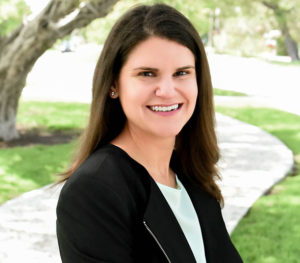

By Alissa Del Riego (May 11, 2022, 5:56 PM EDT)

I started my law career at a large multinational law firm representing corporate clients, and officers and directors defending shareholder derivative claims. The firm had monthly meetings focusing on mentoring and promoting the career development of female attorneys. I thought it was a waste of time.
My clients were diverse, my colleagues were diverse and my co-counsel was diverse. In my summer law clerk class, 80% were law students of color. Women had broken the glass ceiling, and there was a conscious and affirmative effort to increase racial diversity as well. Or so I thought.
A few years later, I changed firm and practices. I entered the federal class action bar. While my colleagues at the law firm I joined were diverse, class counsel on most of the cases I worked on were less so.
Indeed, when I traveled for class action and multidistrict litigation cases in other districts, I often found myself to be the only woman and only Hispanic in the courtroom. Maybe my experiences were an anomaly.
Years later I joined academia, and decided to explore whether my anecdotal observations were reflective of the federal MDL plaintiffs class action bar. They were. A study that looked at a sample of cases in the Northern District of Illinois in 2013 found that only 13% of lead lawyers in class actions were women.[1]
Another study found that, between 2011 and 2015, women were appointed to less than 17% of all leadership positions in MDLs.[2] A more recent study, which looked at data from 2015 to 2019, found that only approximately 5% of attorneys serving as appointed counsel in MDLs identified as nonwhite.[3]
And a methodical study that looked at 73 product liability and sales practices MDLs pending in 2013 (spanning from 1991 to 2013) found that approximately 63% of MDL leadership roles went to the same mostly white and male attorneys.[4] This lack of diversity had also been gaining the attention of the bar, academics and courts.
In 2020, in the In re: Robinhood Outage Litigation, the U.S. District Court for the Northern District of California rejected a joint proposal by attorneys seeking to represent the class, because all 11 of the attorneys put forward to serve were male.[5] Last year, in 2021, the Complex Litigation Center at George Washington University Law School updated a prior report aimed at improving practices to increase diversity among counsel representing class members.[6]
And academics in the last few years have criticized the process by which class counsel is hired as inequitable — and, as Brooke Coleman put it in a 2016 article in the Washington Law Review, “rigged to benefit those [attorneys] in elite circles.”[7]
While this lack of diversity might appear to be simply a woe of the profession, and a sign of female and nonwhite attorneys wanting to rise to the upper echelon of the MDL and class action bar, it actually harms class members. Imagine that all representatives of a teacher’s union are white, all those on a particular company’s compensation committee are men, or all the members of a state’s congressional subcommittee on education are childless.
These scenarios are troubling, because these kinds of collective bodies make decisions that significantly affect the individuals they represent, and such imbalances may result in disparate treatment of certain constituents. And even with the best of intentions, nondiverse groups are prone to miss something.
Class counsel similarly makes decisions on behalf of class members. These attorneys decide what claims to bring forward, what injuries to redress, what litigation strategies to pursue and, in the event of a settlement, what relief would be acceptable to class members.
Importantly, class counsel makes these important decisions with little to no input from its clients — class members. That is why, for example, an all-male attorney team may not be the best counsel to fairly and adequately represent purchasers of a defective birth control pill, or purchasers of another defective drug that caused breast cancer.[8] Yet, in both of these situations, class members were represented by court-appointed all-male legal teams.
Unlike traditional attorney-client relationships, where the client seeks out, interviews and ultimately hires counsel, class counsel often seeks out clients, and a court is tasked with appointing class counsel at certification, and prior to class certification on an interim basis. But the law provides little guidance for courts in selecting counsel.
Federal Rule of Civil Procedure 23 only requires that class counsel be able to fairly and adequately represent the interest of class members. So why do courts repeatedly appoint the same middle-aged white male attorneys, necessarily concluding they are the best to adequately represent the interests of all class members?
I recently examined a subset of class actions to determine what factors might make it more or less likely that diverse counsel would be appointed. I reviewed every auto defect MDL asserting class action claims from the 1970s to 2021.
I looked at: (1) the attorneys that were appointed or served as lead counsel, a member of a plaintiffs’ executive or steering committee, and liaison counsel; (2) the district court that presided over the matter; (3) the appointment processes, if any, employed by the court prior to appointing counsel; and (4) the court’s explanation, if any, for appointing its chosen counsel. Complete and broader findings will be published in a forthcoming volume of the Michigan Journal of Law Reform later this year, but a few findings are highlighted below.
A lack of diversity in the role of class counsel plagued these cases. Women occupied less than 10% of lead counsel positions; the same was true for attorneys of color. Indeed, no woman had been appointed to serve as lead counsel in any auto defect class action until 2014, and since 2014, only two women have been appointed.
The gender of the judge seemed to matter little. Indeed, female district judges seemed surprisingly less inclined to appoint female attorneys to serve as class counsel than male judges.
Judges that formed part of an ethnic minority were more likely to appoint other attorneys of color to serve as class counsel — but not women. Structured application processes appeared to coincide with greater appointments of gender-diverse and racially diverse counsel. But few courts provided significant explanations for their appointments, other than counsel’s prior experience.
Curiously, most courts, in discussing counsel’s relevant experience, limit discussions to the attorney’s prior experience to the same appointed role. This presents a Catch-22, wherein an attorney can only be appointed to serve the class with prior appointment experience, but cannot gain such experience unless previously appointed.
This limited definition of qualifying experience is a large contributing factor to why the plaintiffs class action bar looks much like the rest of the profession did 20 to 30 years ago. Courts must begin by defining experience more broadly — as significant prior service in a similar class action or MDL.
This service should not be limited to appointed roles, but should also include auxiliary roles that perform tasks that are just as important as, if not sometimes more important than, those performed by lead counsel. This does not mean courts should appoint inexperienced attorneys, but rather acknowledge that relevant experience includes five or more years in integral unappointed roles.
I propose that, in order to ensure counsel meets all of Rule 23’s adequacy considerations — which include not only relevant experience, but also the requisite resources to fund the litigation — courts jointly appoint two attorneys to each leadership position: one that meets traditional requirements, and another that can bring diversity, either in terms of identity, or experience in managing relationships with class representatives and class members, to the counsel’s table.
This would not duplicate the number of attorneys working on the case, as class counsel rarely performs appointed tasks alone. But it would double the pool of attorneys qualified for appointment.
Courts must also consistently acknowledge the relevance of diversity to adequate representation of class members. This concentrated effort to focus on diversity will motivate the plaintiffs bar to dedicate resources to providing experience to younger, more diverse lawyers — and to retaining them.
Finally, courts should take the opportunity when appointing counsel to ensure that at least one group of attorneys is both tasked with corresponding with class representatives and class members and participating in settlement negotiations. Courts currently assign general duties to class counsel in written orders, but this does not require that the appointed attorneys individually carry out each of these duties.
If courts were to specifically assign certain duties within the same position to individual attorneys, this would ensure that the same attorneys tasked with communicating with class representatives and members actively participate in settlement negotiations. Thus, even if class counsel is not diverse in identity, counsel at least will have a greater awareness of the interests of diverse class members, and can seek more informed relief for the whole class.
While diversity in the class counsel role will not occur overnight, these steps can accelerate what has been laggard progress, perpetuated to some degree by the judiciary.
Alissa Del Riego is an associate at Podhurst Orseck PA, and is an assistant professor at the University of Miami Herbert Business School.
The opinions expressed are those of the author(s) and do not necessarily reflect the views of the firm, its clients or Portfolio Media Inc., or any of its or their respective affiliates. This article is for general information purposes and is not intended to be and should not be taken as legal advice.
[1] Stephani A. Scharf and Roberta D. Liebenberg, First Chairs at Trial More Women Need Seats at the Table, Am. Bar Assoc., 13 (2015).
[2] Dana Alvaré, Vying for Lead in the “Boys’ Club: Understanding the Gender Gap in Multidistrict Litigation Leadership Appointments, Temple Univ. Beazley Sch. L., 5-6 (2017), https://www2.law.temple.edu/csj/publication/mdl-study/ (women were appointed in a lead role only 16.55% of 145 multidistrict litigation cases between 2011 to 2016 where formal leadership appointments were made by a court of the time).
[3] Amanda Bronstad, Despite Diversity Efforts, Fewer Than 10% of MDL Leadership Posts Are Going to Attorneys Who Are Not White, Law.com, Aug. 17, 2020, https://www.law.com/2020/08/17/despite-diversity-efforts-fewer-than-10-of-mdl-leadership-posts-are-going-to-attorneys-who-are-not-white/.
[4] Elizabeth Chamblee Burch and Margaret S. Williams, Repeat Players in Multidistrict Litigation: The Social Network, 102 Cornell L. Rev. 1445, 1450, 1471 (2017).
[5] See In re Robinhood Outage Litigation , No. 20-cv-01626-JD, at *2 (N.D. Cal. July 14, 2020).
[6] Inclusivity And Excellence: Guidelines and Best Practices for Judges Appointing Lawyers to Leadership Positions in MDL and Class-Action Litigation, James F. Humphreys Complex Litig. Ctr. G.W. L. Sch., Mar. 15, 2021, at 7, PDF link.
[7] Brooke D. Coleman, A Legal Empire: Women In Complex Litigation, 93 Ind. L. J. 617, 618 (2018); Brooke D. Coleman, One Percent Procedure, 91 Wash. L. Rev. 1005, 1011, 1026 (2016).
[8] See In re Prempro Prod. Liab. Litig., 4:03-cv-1507 WRW, Order No. 1 – Practice and Procedure, ECF 15 at 6 (E.D. Ark. June 10, 2003); In re Yasmin & Yaz (Drospirenone) Mktg., Sales Practices & Prod. Liab. Litig., 3:09-md-02100-DRH-CJP, MDL No. 2100, Order #2 Order Appointing Plaintiffs’ Steering Committee, ECF 180 (S.D. Ill. Nov. 10, 2009). One of these attorneys was convicted of a felony attempt to entice a female minor to engage in sexual activity shortly after having been appointed. See U.S. v. Helder , 452 F.3d 751 (8th Cir. 2006).